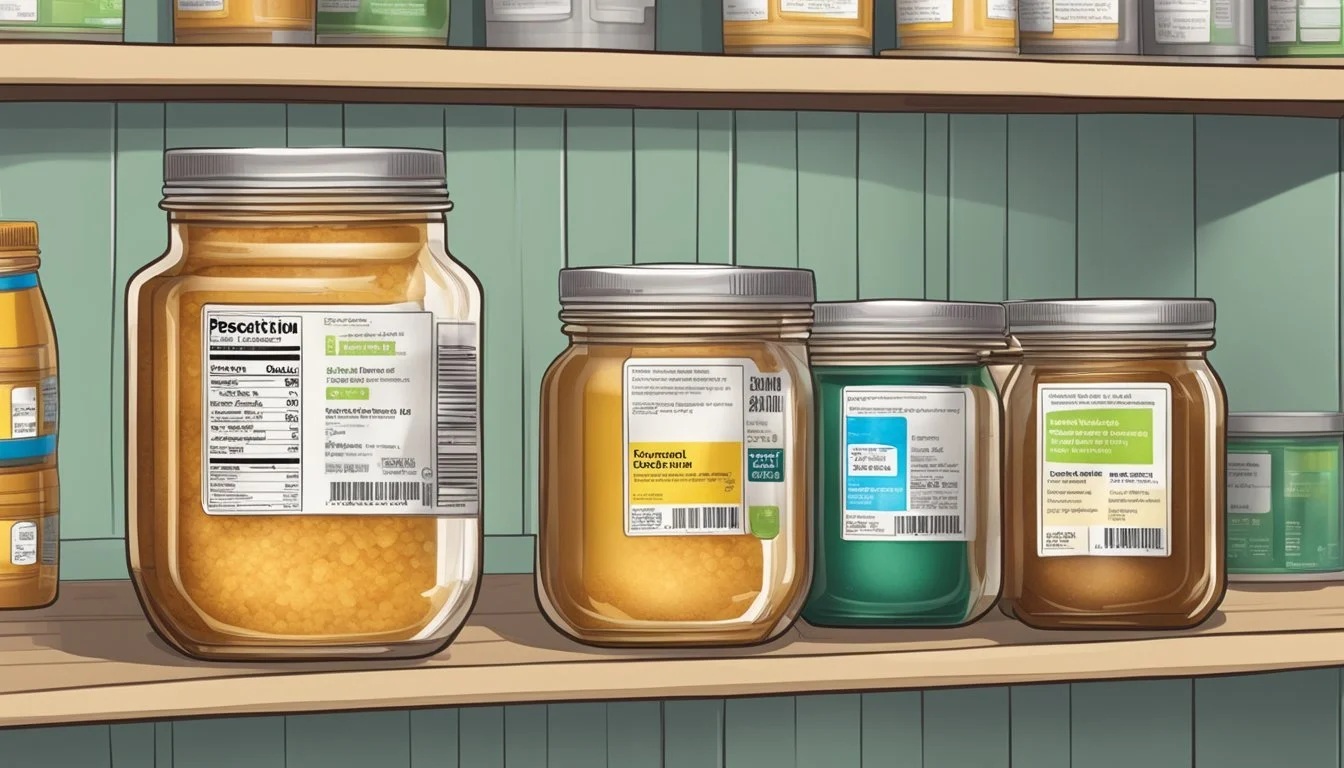Does Pectin Go Bad?
Understanding Shelf Life and Storage Tips
Pectin, a vital ingredient in many culinary creations like jams, jellies, and preserves, often raises the question of whether it goes bad over time. Yes, pectin can go bad, affecting the quality of the food products you make with it. When pectin has gone bad, it may not gel properly, which is crucial for recipes requiring precise textures.
The shelf life of pectin varies depending on its form. Dry pectin, which is made from citrus peel, can last up to two years if unopened and stored in a cool, dry place. Liquid pectin, often derived from apples, typically has a shorter shelf life and should be used within a year for optimal quality. Recognizing spoilage signs like odd odors, color changes, or clumping in powdered pectin can help you determine if it is no longer suitable for use.
Proper storage and timely usage are key to maintaining the efficacy of your pectin, ensuring that your jams and preserves maintain their desired consistency. With a clear understanding of pectin’s shelf life, you can confidently create delicious recipes while preserving the quality of your ingredients.
Understanding Pectin
Pectin is a natural thickening agent found in many fruits. It has unique gelling properties that make it essential in food preparation, especially in making jams and jellies.
Chemical Composition and Properties
Pectin is a polysaccharide, more specifically a soluble fiber, that naturally occurs in the cell walls of plants. It is made up of long chains of galacturonic acid molecules. The degree of esterification (DE) of these molecules determines whether pectin is high methoxyl (HM) or low methoxyl (LM). High methoxyl pectin forms gels in the presence of sugar and acid, while low methoxyl pectin requires calcium ions to gel. These differing properties make pectin a versatile thickening and gelling agent in food processing.
Different Types of Pectin
There are several types of pectin available: powdered pectin, liquid pectin, high methoxyl pectin, low methoxyl pectin, and modified citrus pectin. Powdered and liquid pectin are not interchangeable due to differences in their preparation methods and reactivity. High methoxyl pectin, commonly used in commercial pectin products, requires higher sugar concentrations and acidic conditions to set. In contrast, low methoxyl pectin can gel with lower sugar content but needs calcium for the gelling process. Modified citrus pectin is altered to improve its solubility and functionality in different applications.
Pectin Sources
Natural sources of pectin include citrus peels, apples, plums, and other high-pectin fruits. Apples, especially green apples, are noted for their high pectin content and are frequently used in homemade pectin preparation. Citrus peels from oranges, lemons, and grapefruits are another rich source. Pectin can also be derived from rhubarb and other plants, though in varying amounts. Commercial pectin is often extracted from these high-pectin fruits and standardized for consistent gelling properties. Low-pectin fruits, such as strawberries and cherries, typically require added pectin to achieve the desired consistency in jams and jellies.
Pectin's Role in Cooking and Culinary Uses
Pectin is a crucial ingredient for achieving the desired texture and consistency in various culinary applications. Its primary uses include making jams and jellies, but it also finds its way into other recipes like baked goods and even some medicinal products.
Making Jams and Jellies
Pectin is essential for creating the gel-like consistency in jams and jellies. Naturally found in the cell walls of fruits such as apples and citrus peels, pectin forms a gel when combined with sugar and acid during the cooking process. This gelling process is vital for the texture and spreadability of apple jelly, strawberry jams, and other fruit preserves.
The amount of pectin in different fruits varies, so sometimes additional powdered pectin is added to ensure proper gelling. When heating the fruit mixture, pectin, sugar, and acid react to form that perfect spreadable consistency. Pectin not only enhances the texture but also allows jams and jellies to set faster, preserving the fresh taste of the fruit.
Alternative Uses in Baking and Medicine
Beyond jams and jellies, pectin serves other roles in baking and even medicinal applications. In baking, pectin is often used to improve the texture of baked goods such as pastries and fillings. It helps stabilize fillings, preventing them from becoming too runny, and maintains the desired consistency.
Modified citrus pectin (MCP), a type of pectin that undergoes chemical alteration, finds usage in medicinal contexts. MCP is believed to have health benefits, including potential uses in detoxifying the body and supporting heart health. While evidence varies, this highlights pectin's versatility beyond culinary uses, extending into areas where its gelling and thickening properties are beneficial.
Storage and Shelf Life
Pectin, whether liquid or powdered, has specific storage needs to maintain its effectiveness and quality. Properly storing pectin enhances its shelf life and ensures optimal gelling properties.
Optimal Storage Conditions
To preserve pectin's potency, it is best stored in a cool, dry place. Avoid direct sunlight and areas with high humidity to prevent spoilage.
Unopened powdered pectin can last up to two years if stored in these conditions. Unlike liquid pectin, which generally has a shorter unopened shelf life, powdered pectin is more stable. Opened pectin should be sealed tightly and stored in the refrigerator; it is best used within 6-12 months to maintain quality. Freezing is not necessary and can alter the texture of liquid pectin.
Determining Pectin Expiration
Checking the expiration date on the packaging is crucial to determine pectin's freshness and effectiveness. Beyond this date, pectin may lose its gelling properties.
Expired pectin won't pose a food safety risk but will affect the quality of the food products. Indicators like smell, taste, texture, and color changes can signal that pectin's effectiveness has degraded. The importance of using pectin at its peak potency cannot be overstated for achieving the desired results in recipes.
Dealing with Expired Pectin
When pectin has passed its expiration date, its gelling capacity diminishes. This impacts the thickness and consistency of jams, jellies, and other recipes.
It's advisable to replace expired pectin to ensure the best results, although it can still be experimented with in non-critical applications. Always check for changes in smell, taste, and texture before deciding to use it. If any noticeable degradation is identified, it's better to dispose of it to avoid disappointing culinary outcomes.
Safety and Health Considerations
Pectin is widely used in food products and supplements, and understanding its safety and health implications is crucial. This section will explore the potential health impacts, precautions for use, and the regulatory status of pectin supplements.
Impact on Health
Pectin, a soluble fiber, is beneficial for various health reasons. It can help lower high cholesterol levels, reducing the risk of heart disease. Studies show that pectin may aid in managing blood sugar levels, particularly for those with diabetes.
However, excessive consumption can lead to digestive issues, such as diarrhea and gas. Modified citrus pectin is studied for its potential role in fighting prostate cancer. Pectin supplements are generally safe for most people, but consult with a healthcare provider before starting new supplements, especially for children or those with specific health conditions.
Usage Precautions
Proper storage of pectin is critical to maintain its effectiveness and safety. Store in a cool, dry place to prevent degradation, which can compromise food safety. Avoid using pectin past its expiration date as it can lose its gelling properties and may pose a risk of contamination.
Pectin can interact with certain medications by affecting their absorption. Individuals taking medication for high cholesterol or diabetes should be cautious. Always check for any possible allergens in pectin products and be mindful of potential contaminants, such as lead, which could be harmful.
Regulatory Status of Pectin Supplements
Pectin supplements fall under the oversight of the Food and Drug Administration (FDA). However, they are not subject to the same rigorous safety testing as pharmaceuticals. The FDA ensures that pectin used in food products meets food safety standards.
Consumers should look for supplements that are labeled as USP-verified or have third-party testing to ensure quality and safety. Regulations vary by country, so ensure that the product complies with local regulatory standards. Always research and choose reputable brands to avoid harmful additives or contaminants.
By considering these safety and health factors, individuals can make informed decisions about incorporating pectin into their diets safely and effectively.
Optimizing Pectin Use for Quality Results
Proper pectin use ensures high-quality homemade preserves. Efficient selection, storage, and troubleshooting processes enhance texture and consistency while maintaining the potency of pectin over time.
Pectin Selection and Recipe Adjustments
Selecting the right type of pectin is crucial. High methoxyl pectin works well with high-sugar recipes and acidic ingredients. It forms a strong gel, ideal for traditional jams and jellies. Low methoxyl pectin is suitable for low-sugar or no-sugar recipes and utilizes calcium to create a gel, allowing for healthier preserves.
Adjusting recipes to accommodate the type of pectin used is essential. Changes in sugar content, acidity levels, and the type of fruit can impact gelling. Reading product-specific instructions and conducting small tests helps achieve optimal results.
Troubleshooting Pectin in Home Cooking
Home cooks may encounter issues such as a failure to gel or inconsistent texture. Common causes include using expired pectin or not following recipe instructions carefully. Ensuring pectin potency by checking the expiration date and storing it in a cool, dry place minimizes these problems.
If a batch fails to gel, reboiling with added pectin or acid can often correct the issue. Being attentive to proportions of sugar, acid, and cooking time also helps in troubleshooting, avoiding runny or too-thick preserves.
Advantages of Proper Pectin Preservation
Proper storage extends the shelf life of pectin, preserving its gelling properties. Unopened dry pectin can last up to two years, whereas liquid pectin should be used within a year for peak quality. Once opened, both forms of pectin should ideally be used within 6-12 months.
Storage tips: Keep pectin in its original packaging, tightly sealed, and store in a cool, dry place. Avoid exposing pectin to moisture and extreme temperatures, as these conditions can degrade its effectiveness. Proper storage ensures that pectin retains its potency, resulting in high-quality, well-gelled preserves every time.





